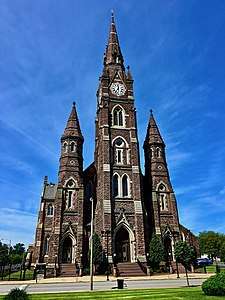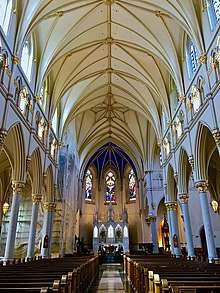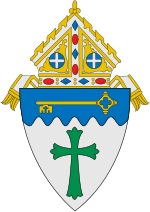St. Peter Cathedral (Erie, Pennsylvania)
St. Peter Cathedral is a Roman Catholic church located at 230 West 10th Street (at Sassafras Street) in Erie, Pennsylvania.
| Saint Peter Cathedral | |
|---|---|
 | |
 Location in Pennsylvania | |
| 42°7′27″N 80°5′13″W | |
| Location | 230 West 10th Street Erie, Pennsylvania |
| Country | United States |
| Denomination | Roman Catholic |
| Website | stpetercathedral |
| History | |
| Status | Cathedral |
| Founded | February 1873 |
| Dedication | Saint Peter |
| Dedicated | August 2, 1893 |
| Consecrated | May 17, 1911 |
| Architecture | |
| Functional status | Active |
| Architect(s) | Patrick Keely |
| Style | Gothic Revival |
| Groundbreaking | August 1, 1875 |
| Construction cost | $274,000 |
| Specifications | |
| Length | 220 ft (67 m) |
| Width | 112 ft (34 m) |
| Number of spires | 3 |
| Spire height | 298 ft (91 m) Central 150 ft (46 m) Side |
| Materials | Sandstone |
| Bells | 12 |
| Tenor bell weight | 4,500 lb (2,040 kg) |
| Administration | |
| Diocese | Erie |
| Province | Philadelphia |
| Clergy | |
| Bishop(s) | Most Rev. Lawrence Persico |
| Rector | Rev. Michael Ferrick |
History
Plans for the building of St. Peter Cathedral were initiated in 1873 by Bishop Tobias Mullen of the Roman Catholic Diocese of Erie. The cornerstone was laid in a formal ceremony held on St. Peter in Chains Day (See General Roman Calendar as in 1954), 1 August 1875. After years of construction and a fundraising campaign that involved parishes throughout the diocese, the cathedral was completed in 1893. The architect was Patrick Keeley of Brooklyn, a prolific designer of churches whose works include 21 cathedrals in the eastern United States.[1][2]
Specifications

The cathedral is Gothic revival in the French Victorian tradition called Second Empire. Much of the stone for the foundation came from dismantling the locks of the Erie Extension Canal, which closed in 1871. The exterior consists of red sandstone from Medina, New York and white sandstone trim from Amherst, Ohio and Mercer County, Pennsylvania.[1][3]
The central bell tower stands 298 feet (91 m) tall, while twin Norman style towers at 150 feet (46 m) each bracket the central tower. The bell tower contains a chime of twelve bells weighing 14 tons cast in 1903 by the Andrew Meneely Bell Foundry of West Troy, New York. The E. Howard Clock Company of Boston, New York, and Chicago, installed the clock in the tower, also in 1903.[1][4][5][6]
The stained glass in the sanctuary and transept was installed by the Franz Mayer firm of Munich, Germany and includes depictions of the Annunciation, the Birth of Jesus, the Crucifixion, the Resurrection, the Ascension, and the Second Coming. Large side windows show the Conferral of Keys to Saint Peter and Jesus' supper at the house of the Publican. There are also stained glass windows of the Life of St. Peter and four of the Western Doctors of the Church. Renovations in 1992-1993 included the resetting of all the stained glass and the installation of many glass prisms to refocus sunlight into the interior.[1]
The cathedral organ, which expresses a great variety of organ timbres in the French tradition, was built by Casavant Frères of Montreal, Quebec, Canada and installed in 1977. Additions were made in 1999. It is the third instrument since the building was built.[1]
From the nave of the church, one can see a collection of the likenesses of the diocese's nine bishops and Auxiliary Bishop Edward P. McManaman, who served as Cathedral Rector from 1936 to 1948.[1]
The cathedral has a new baptistery. The center aisle is of Spanish and Italian marble. Carved onto the marble at the front of the church is the large seal to the Diocese of Erie with the coats of arms of Pope Leo XIII and Bishop Mullen on the right and those of Pope John Paul II and Bishop Trautman on the left.[1]
The sanctuary area contains the altar, with the reliquary chest beneath it, and the Bishop's cathedra and the pulpit (strictly "ambo") for preaching. The Blessed Sacrament is maintained in the tabernacle on the north side of the cathedral. The marble high altar constructed in 1911 was used until liturgical changes were made after the Second Vatican Council in the 1960s.[1]
The all-boys high school Cathedral Preparatory School is located behind the Cathedral, hence the name. In its early years, classes were held in the Cathedral's rooms.
References
- "History of St. Peter Cathedral". Retrieved 2007-05-20.
- Bates, Samuel P., History of Erie County, Pennsylvania, 1884, Part III, Chapter IV; Bates refers to the architect as C. C. Keeley, of Brooklyn, NY.
- Bates, Samuel P.; many precise measurements are provided in this text, but construction was not yet completed.
- Bates, Samuel P.; many precise measurements for the towers are provided in this text, all of which conflict with the church history, but construction was not yet completed. Specifically, Bates reported that the central tower was to be 129 feet (39 m) plus a 122-foot (37 m) spire for a total of 251 feet (77 m), and the twin towers were to be 89 feet (27 m) tall with 37-foot (11 m) spires for a total height of 126 feet (38 m), all measures from the pavement level. Bates noted that the central tower was 34 feet (10 m) square at the base, while the twin towers were each 20 feet (6.1 m) square at the base.
- The Antique Clock Guy, a website, reports that Edward Howard (1813-1904) sold his clock and watch business in 1881 to new owners, who continued to sell clocks, mostly by special order. The company name was changed to E. Howard Clock Company in 1903.
- The Bell Casters of Troy
External links
| Wikimedia Commons has media related to Saint Peter Cathedral (Erie, Pennsylvania). |
